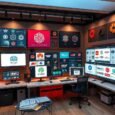Introduction to Leonardo AI Image Generator
In the rapidly evolving world of artificial intelligence, the Leonardo AI Image Generator has emerged as a powerful tool for artists, designers, and content creators. This innovative software harnesses the capabilities of AI to produce stunning visual artworks, allowing users to explore their creative potential like never before. As technology continues to advance, the integration of AI into the creative process is reshaping the landscape of digital art. This article delves into the features, benefits, and applications of the Leonardo AI Image Generator, highlighting how it empowers users to push the boundaries of their imagination.
Understanding Leonardo AI Image Generator
The Leonardo AI Image Generator is a state-of-the-art application designed to create images from textual descriptions. It employs deep learning algorithms and neural networks to interpret user input and generate visually appealing artwork. Unlike traditional image editing software that requires manual adjustments, Leonardo AI streamlines the creative process by automating image generation based on predefined parameters.
How It Works
At its core, the Leonardo AI Image Generator utilizes a combination of Natural Language Processing (NLP) and computer vision technologies. Users provide textual prompts that describe the desired image, and the AI interprets this input to generate corresponding visuals. The model has been trained on a vast dataset of images and their associated descriptions, allowing it to understand context, styles, and themes effectively. As a result, users can create anything from abstract designs to realistic portraits simply by inputting descriptive phrases.
Key Features
The Leonardo AI Image Generator comes equipped with several features that enhance its usability and creative potential. One of the most significant features is the ability to generate high-resolution images, making it suitable for both digital and print applications. Additionally, the software offers customization options, allowing users to adjust parameters such as style, color scheme, and composition. This level of control ensures that the final output aligns with the user’s vision while still benefiting from the AI’s creative capabilities.
Another noteworthy feature is the interactive interface, which provides real-time previews of the generated images. Users can tweak their prompts or parameters and instantly see how these changes affect the output. This iterative process fosters creativity, encouraging exploration and experimentation.
The Creative Potential of Leonardo AI Image Generator
The Leonardo AI Image Generator opens up a world of possibilities for creators across various domains. From artists seeking inspiration to marketers aiming for eye-catching visuals, its applications are vast and varied.
Enhancing Artistic Expression
For artists, the Leonardo AI Image Generator serves as a valuable tool for brainstorming and idea generation. It can help artists overcome creative blocks by providing unexpected visual interpretations of their concepts. By simply inputting a few descriptive words, artists can receive a plethora of images that may spark new ideas or directions for their work.
Moreover, the AI’s ability to mimic different artistic styles allows artists to experiment with aesthetics they may not typically explore. For instance, a painter can generate a digital version of their artwork in a cubist style, offering insights into how different techniques could alter their original vision.
Streamlining Content Creation
Content creators, including graphic designers, social media managers, and marketers, can greatly benefit from the Leonardo AI Image Generator. The software significantly reduces the time and effort required to produce high-quality visuals. Marketers can generate attention-grabbing graphics for campaigns, while social media managers can create engaging posts that increase audience interaction.
Additionally, the AI’s capability to produce images tailored to specific themes or messages ensures that content aligns with branding and marketing strategies. For example, a travel agency can generate stunning landscapes that evoke wanderlust, effectively capturing the essence of their offerings.
Facilitating Collaboration
The collaborative potential of the Leonardo AI Image Generator is another aspect worth exploring. Artists and designers can use the AI to generate initial concepts for projects, which can then be refined and customized based on team feedback. This collaborative approach not only enhances creativity but also fosters a sense of teamwork in the artistic process.
Furthermore, the AI can act as a bridge between different creative disciplines. For instance, a writer can collaborate with a visual artist by generating images that complement their narratives. This synergy between text and visuals can lead to the creation of compelling multimedia content.
Applications Across Industries
The versatility of the Leonardo AI Image Generator makes it applicable in various industries, from entertainment and advertising to education and gaming. Each sector can leverage the tool to enhance creativity and productivity.
Entertainment and Media
In the entertainment industry, the Leonardo AI Image Generator can be used for concept art, character design, and promotional materials. Game developers can quickly generate characters and environments, streamlining the design process and allowing for rapid prototyping. Similarly, filmmakers can visualize scenes or settings before shooting, making it easier to convey their vision to the production team.
Advertising and Marketing
Advertising agencies can utilize the AI to create eye-catching visuals for campaigns, social media posts, and digital ads. By generating multiple variations of an image, marketers can test different creative approaches to determine which resonates best with their target audience. This data-driven method can enhance campaign effectiveness and drive better results.
Education and Training
In educational settings, the Leonardo AI Image Generator can be employed as a teaching aid. Educators can generate images that illustrate complex concepts, making learning more engaging for students. Additionally, art programs can incorporate the AI into their curriculum, allowing students to experiment with digital art creation and explore new techniques.
Challenges and Considerations
While the Leonardo AI Image Generator presents numerous advantages, it is essential to acknowledge the challenges and considerations associated with its use. As with any technology, there are potential ethical implications, particularly concerning copyright and originality.
Ethical Implications
The use of AI in creative fields raises questions about authorship and ownership of generated content. Since the AI learns from existing artworks, it is crucial to consider whether the images it produces are truly original or derivative. Creators must navigate these ethical waters carefully, ensuring they respect the rights of original artists while utilizing the AI’s capabilities.
Quality Control
While the AI is capable of generating impressive visuals, it is not infallible. Users may encounter instances where the generated images do not meet their expectations or fail to capture the intended message. Therefore, human oversight is necessary to ensure that the final products align with the desired quality and artistic vision. Creatives should view the AI as a tool to enhance their work, rather than a replacement for their skills and judgment.
The Future of AI in Creative Industries
As technology continues to advance, the role of AI in creative industries is poised to expand further. The Leonardo AI Image Generator represents just one example of how AI can augment human creativity, and it is likely that we will see more sophisticated tools emerge in the coming years.
Advancements in AI Technology
Future developments in AI technology may lead to even more powerful image generation capabilities. Improved algorithms could enable the AI to understand context and nuance better, resulting in more accurate and nuanced visual outputs. Additionally, advancements in machine learning could allow the AI to learn from user preferences, creating a more personalized experience for each creator.
Integration with Other Technologies
The integration of the Leonardo AI Image Generator with other technologies, such as virtual reality (VR) and augmented reality (AR), offers exciting possibilities. For instance, artists could generate 3D visuals that can be experienced in immersive environments, transforming the way audiences engage with art. This cross-pollination of technologies may redefine artistic expression and open new avenues for creative exploration.
Conclusion
The Leonardo AI Image Generator is a groundbreaking tool that empowers creators to explore their artistic potential in innovative ways. By leveraging the capabilities of artificial intelligence, artists, designers, and content creators can enhance their workflows, generate unique visuals, and collaborate seamlessly across disciplines. While challenges and ethical considerations remain, the potential benefits of AI in the creative realm are undeniable.
As we look toward the future, the integration of AI into the creative process will likely continue to evolve, offering new opportunities for artistic expression. Whether you are a seasoned artist or a budding creator, embracing tools like the Leonardo AI Image Generator can unlock new dimensions of creativity, allowing you to push the boundaries of what is possible in the world of digital art.



